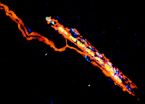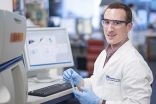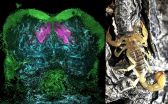(Press-News.org) There are two main families of bacteria : those that are surrounded by a single membrane (or one outer wall) and those that are surrounded by two membranes (or two outer walls). The team of Jean-François Collet, professor at the de Duve Institute at UCL, looked at this second type of bacteria.
For a bacterium to survive, it has to keep its two outer walls intact. If one of these walls is damaged, the bacterium dies. So it was vital for the UCL researchers to analyse the protection mechanisms of these bacterial "walls' (to find their weak spot), so as to be able to fight these defence systems more effectively by developing new antibiotics.
The researchers examined a protein that is found between these two protective walls, known as RcsF. When all is well, this protein is continually sent to the second outer wall. However, if the bacterium is attacked (by an antibiotic, for instance) the machinery that sends RcsF to the outer wall no longer works: instead of being on the second outer wall, RcsF is stuck between the two fortifications (membranes), from where it sends out an alarm signal. This signal prompts the bacterium to trigger defence systems (by sending other back-up proteins) so as to resist the attacking antibiotic.
In this process, the UCL researchers succeeded in discovering how the protein RcsF manages to sound the alarm. In practical terms, when it is stressed, stuck between the two walls, RcsF contacts another protein, IgaA. The interaction between these two proteins raises the alarm.
What was the point of discovering this alarm mechanism?
In terms of basic research, the researchers wanted to understand how the alarm system worked. They made a twofold, unexpected discovery: the fact that the protein RcsF positions itself on the second outer wall (on the surface of the bacterium) and the fact that it interacts with a second protein, IgaA. This discovery gives rise to other interesting questions, since it suggests that other proteins may take the same path;
In terms of applied research, given that this alarm helps defend bacteria against antibiotics, the UCL researchers aimed to gain a better understanding of how these proteins work so as to be able to develop new antibiotics, which would bypass this alarm system and hence, ultimately, fight more effectively against bacterial infections (such as urinary infections linked to the bacterium Escherichia-coli, for example). To be specific, the researchers believe that it will be possible to use the proteins in this system as a target to break through the bacteria's defence system and create new antibiotics.
The resistance of certain bacteria to antibiotics is currently a major health problem. More and more bacteria are becoming resistant to the antibiotics available at the moment, because they are acquiring new defence mechanisms. The UCL discovery could therefore provide a response to this growing problem.
INFORMATION:
This research was conducted at the de Duve Institute, UCL, by an international team (Korea, Poland,
Lebanon, France, Belgium) of around ten microbiologists and biochemists, in collaboration with a group from the European Molecular Biology Laboratory (EMBL, Germany). The main funding for this research project comes from Welbio (Walloon institute that aims to support excellent research in the field of life sciences). It is thanks in particular to Welbio that Jean-François Collet was able to recruit an experienced researcher from Harvard University.
This latest research by Joshua Brickman and his research team from Danish Stem Cell Center (Danstem) at the University of Copenhagen specifically found that inhibiting or blocking stem cells ability to make a specific decision, leads to better cell growth and could lead to defined ways to differentiate stem cells.
This research is the first comprehensive analysis of a pathway important for stem and cancer cell decisions known as Erk. As a result this work could contain clues to cancer treatment as well as helping to establish a platform to make stem cell treatments for ...
After an incomplete spinal cord injury, the body can partially recover basic motor function. So-called muscle spindles and associated sensory circuits back to the spinal cord promote the establishment of novel neuronal connections after injury. This circuit-level mechanism behind the process of motor recovery was elucidated by Prof. Silvia Arber's research group at the Biozentrum, University of Basel and the Friedrich Miescher Institute for Biomedical Research. Their findings may contribute to designing novel strategies for treatment after spinal cord injuries and have ...
Walter and Eliza Hall Institute researchers have for the first time revealed how dying cells are hidden from the immune 'police' that patrol the body.
The research answers a decades-old mystery about the death of cells, which in some situations can alert the immune system to potential danger, but in other circumstances occurs 'silently', unnoticed by immune cells.
Silent cell death, or apoptosis, is a controlled way for the body to eliminate cells that may be damaged, old, or surplus to the body's requirements, without causing collateral damage. This 'normal' cell death ...
This news release is available in Spanish. The genome is the cell's book of instructions. All the cells in our body contain the same genomic information but each of them "reads" the gene fragments that interest them in order to carry out their function. So, neurones, hepatocytes and cardiac cells are different although their genome is the same. In order to achieve this huge variety of functions from the same genome, the cells employ a mechanism known as alternative splicing. This enables them to combine several fragments - known as exons - from the same genes in order ...
Mountain View, Calif. - December 18, 2014 - 23andMe, Inc., the leading personal genetics company, today announced the publication of a study that pinpoints fine-scale differences in genetic ancestry of individuals from across the United States.
Since immigrants first arrived more than four hundred years ago, the United States has served as a meeting place for peoples from different continents. This study illuminates how American history and the ongoing mixing of peoples with African, European, and American origins can be seen in our DNA.
"The relationship between genomics ...
HOUSTON - (Dec. 18, 2014) - Cars that run on natural gas are touted as efficient and environmentally friendly, but getting enough gas onboard to make them practical is a hurdle. A new study led by researchers at Rice University promises to help.
Rather than shoehorn bulky high-pressure tanks like those used in buses and trucks into light vehicles, the Department of Energy (DOE) encourages scientists to look at new materials that can store compressed natural gas (CNG) at low pressure and at room temperature. Cage-like synthetic macromolecules called metal organic frameworks ...
LA JOLLA, CA--December 18, 2014--Collaborating scientists from The Scripps Research Institute (TSRI) and the University of California (UC) San Diego have developed a powerful new system for studying how proteins and other biological molecules form and lose their natural folded structures.
Using the new system, researchers can force a sample of molecules to unfold and refold by boosting and then dropping the temperature, so quickly that even some of the fastest molecular folding events can be tracked.
"One way of studying these structures has been to make them unfold ...
Whether you're cramming for an exam or just trying to remember where you put your car keys, learning and memory are critical functions that we constantly employ in daily life.
It turns out that the structure and function of brain centers responsible for learning and memory in a wide range of invertebrate species may possibly share the same fundamental characteristics, according to a new study published in the journal Current Biology and performed by University of Arizona neuroscientists Nicholas Strausfeld, Regents' Professor in the Department of Neuroscience, part of ...
ST. LOUIS - Saint Louis University research findings published in the December issue of Antimicrobial Agents and Chemotherapy report a family of molecules known as nucleotidyltransferase superfamily (NTS) enzyme inhibitors are promising candidates for new herpes virus treatments.
The findings could lead to new treatment options for herpes that patients can use in conjunction with or instead of currently approved anti-viral medications like Acyclovir. Researcher Lynda A. Morrison Ph.D., professor of Molecular Microbiology and Immunology at Saint Louis University, likened ...
Why are older people at higher risk for developing cancer? Prevailing opinion holds that, over time, your body's cells accumulate DNA damage and that eventually this damage catches up with the body in a way that causes cancer. A University of Colorado Cancer Center study published today in the journal Aging shows that this prevailing opinion is incomplete. In addition to DNA damage, cancer depends on the slow degradation of tissue that surrounds cancer cells, something that naturally comes with aging.
"It's really all about natural selection and survival of the fittest," ...





